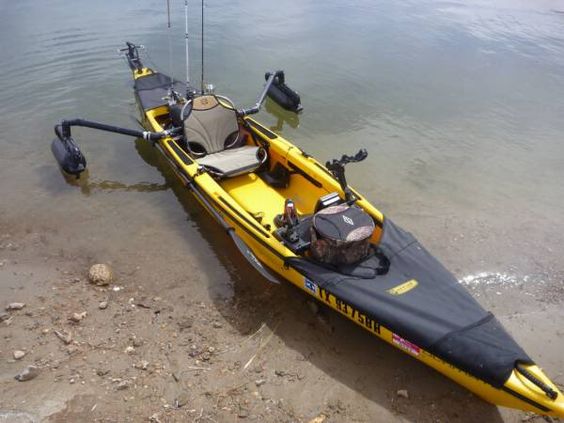
Life doesn’t get much better than a day fishing trip by canoe. You are so close to nature you can literally touch it. You have the chance to return for a day, to the time when people lived off the land in very tangible ways.
But if you don’t pack the right items for your day trip, not having what you need can interfere with your trip enjoyment and productivity. In this article, learn what to bring and how to prepare for a day of fishing on your canoe.
First Things First: Weight Matters
Fishing on a canoe, gives you precious little room to carry extra cargo. Weighty cargo can be more problematic still. So you want to be sure that every item you bring can pull its weight during your trip.
Some experts recommend packing no more than 13 pounds worth of extra personal gear (above and beyond your fishing gear). Others caution that it is best not to exceed what you can personally carry weight-wise. The total weight limit of your personal canoe craft should be the final authority on how much extra weight you can comfortably and safely transport.
Next Up: Travel Itinerary Materials
It is very important to map out your proposed itinerary before you depart and make several copies. Give one copy to a close friend or family member and let them know whom to call if you do not check in or return by a certain time. This is for your own safety. When you are out in the wilderness, you can never fully anticipate what might happen!
It is also wise to assemble just the essential personal I.D. items you truly need. Here is a suggested list:
– Driver license.
– Health insurance card.
– Credit card.
– Cash (small bills are best).
– Fishing license or permit (as applicable).
– Lodging reservation (as applicable).
– Travel maps.
– One waterproof pouch to store these items inside.
Don’t Skip! First Aid
Since you will be relatively on your own once you are out in your canoe, you will want to have the basic first aid supplies on hand just in case. Even a small nick or scratch can easily become infected when you are working around hooks, live bait and fish.
Here is a suggested starter list for assembling a lightweight, portable first aid kit for your fishing trip:
– Band-Aids (several sizes).
– Sterile gauze.
– Antiseptic wipes.
– Antibacterial hand gel or spray.
– Antibiotic cream or gel.
– Sutures (stitches).
– Duct tape.
– Scissors (capable of cutting a metal fish hook).
– Strong tweezers or pliers (capable of pulling a fish hook out of skin).
– Sport tape.
– Pain relievers.
– Sunscreen.
– Water purification tablets or drops.
– Bug spray.
– Lighter or waterproof matches.
– Any personal prescription medications you may need.
– An extra pair of any prescription eyewear you may need.
– A first aid book describing basic emergency procedures.
By taking the time to pre-assemble a basic first aid kit that directly addresses common fishing injuries (ex: fish hooks lodged in skin, cuts, scrapes, sunburn, windburn, et al), you can reduce the chances of your enjoyment being marred by minor injuries or discomforts.
For safety reasons, it is not advisable to rely on cell phone signals when you are in a remote location. So you should always plan for other communication methods if the need arises, with these or similar supplies:
– Flares.
– Loud whistle.
– Flashlights equipped with S.O.S. flashers.
– Signaling mirror (can reflect sunlight for a flare-like visual effect).
– Flag or reflective tape (bring a marker to write instructions on the tape).
– Personal satellite-enabled emergency beacon.
Water and Food
Yes, you may be literally “fishing for your supper,” but unless you love sushi, you may want to bring other rations for your day of fun. Canoeing takes a lot of energy and so does the concentration required to watch for signs of fish and reel in the “big one.”
If you aren’t keen on doing any actual cooking during your trip, or you plan to be home in time for dinner, you won’t need to bring any fuel or cooking equipment. What you will need is plenty of drinking water and travel rations. Here is a helpful list you can use for brainstorming day trip snacks and meals:
– Your body naturally loses up to 2.5 gallons of water every day even when you are not doing any strenuous activity. So you will need to bring a minimum of 3 gallons of water per person on your day trip.
– Energy bars are a great source of quick nutrition when you are busy fishing.
– Nuts, trail mix, jerky, hard boiled eggs and cheese cubes are all good quick protein sources.
– Crackers, cookies, chips are all good quick sources of carbohydrates.
– Making some peanut butter and jelly sandwiches can tide you over as well.
Clothing and Shoes
Finally, you should carefully plan what you wear. Try to bring extras of essentials like shoes and socks just in case anything ends up going overboard!
Some of the new sport clothing and hats are very lightweight, can block UV rays and work as an insect repellant, so if your budget permits, consider investing in at least one set of this clothing.
Also don’t forget to bring a windbreaker – it can be surprisingly chilly during early mornings or late evenings when the wind kicks up!
Through careful planning and preparation, you can make sure your day fishing trip by canoe is as enjoyable, fish-full and fun as possible. You may not use absolutely everything you bring with you, but just having it there will give you precious peace of mind to relax, enjoy the chance to be with nature and focus on getting a great fresh fish haul!